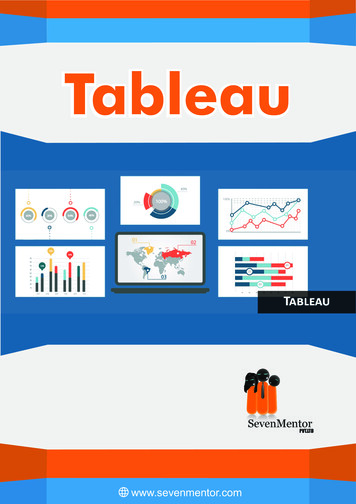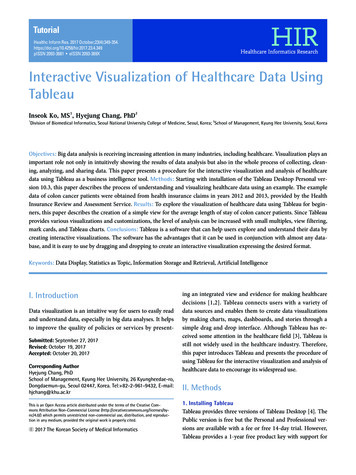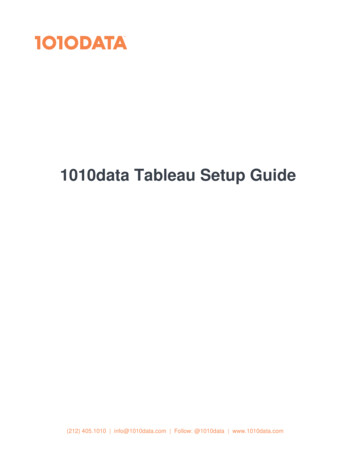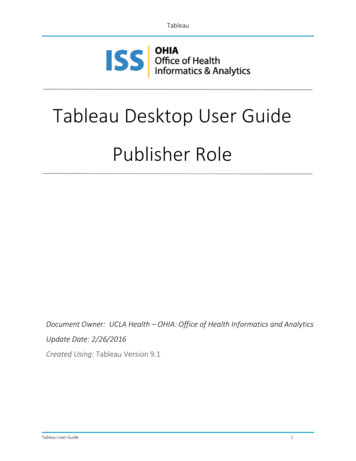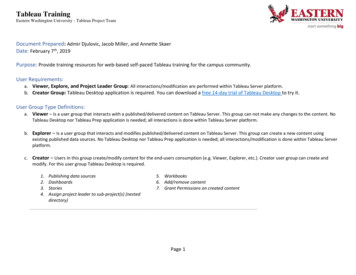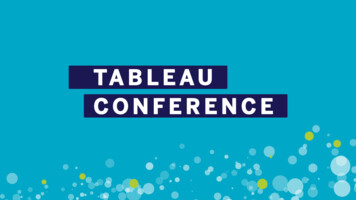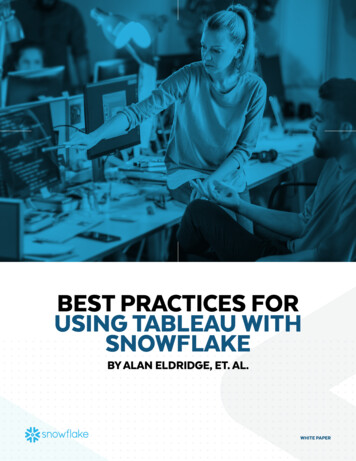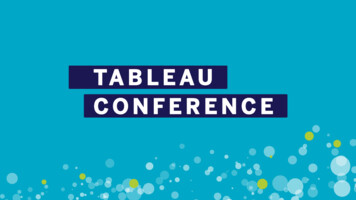
Transcription
Recommendations for Visualization Recommendations:Exploring Preferences and Priorities in Public HealthCalvin Baocsbao@umd.eduUniversity of MarylandCollege Park, MD, United StatesSiyao Lisiyaoli@terpmail.umd.eduUniversity of MarylandCollege Park, MD, USAMichael CorrellLeilani Battlemcorrell@tableau.comTableau ResearchSeattle, WA, USAABSTRACTThe promise of visualization recommendation systems is that analysts will be automatically provided with relevant and high-qualityvisualizations that will reduce the work of manual exploration orchart creation. However, little research to date has focused on whatanalysts value in the design of visualization recommendations. Weinterviewed 18 analysts in the public health sector and exploredhow they made sense of a popular in-domain dataset1 in serviceof generating visualizations to recommend to others. We also explored how they interacted with a corpus of both automaticallyand manually-generated visualization recommendations, with thegoal of uncovering how the design values of these analysts arereflected in current visualization recommendation systems. We findthat analysts champion simple charts with clear takeaways that arenonetheless connected with existing semantic information or domain hypotheses. We conclude by recommending that visualizationrecommendation designers explore ways of integrating context andexpectation into their systems.CCS CONCEPTS Human-centered computing Visualization design andevaluation methods; Visualization systems and tools; Userstudies.KEYWORDSVisualization recommendation systems, algorithmic trust, automation, recommendation sourceACM Reference Format:Calvin Bao, Siyao Li, Sarah Flores, Michael Correll, and Leilani Battle. 2022.Recommendations for Visualization Recommendations: Exploring Preferences and Priorities in Public Health. In CHI Conference on Human Factors1 NationalHealth and Nutrition Examination Study 2013-2014 [3].Permission to make digital or hard copies of all or part of this work for personal orclassroom use is granted without fee provided that copies are not made or distributedfor profit or commercial advantage and that copies bear this notice and the full citationon the first page. Copyrights for components of this work owned by others than theauthor(s) must be honored. Abstracting with credit is permitted. To copy otherwise, orrepublish, to post on servers or to redistribute to lists, requires prior specific permissionand/or a fee. Request permissions from permissions@acm.org.CHI ’22, April 29-May 5, 2022, New Orleans, LA, USA 2022 Copyright held by the owner/author(s). Publication rights licensed to ACM.ACM ISBN 978-1-4503-9157-3/22/04. . . 15.00https://doi.org/10.1145/3491102.3501891Sarah Floressflores3@terpmail.umd.eduUniversity of MarylandCollege Park, MD, USAleibatt@cs.washington.eduUniversity of WashingtonSeattle, WA, USAin Computing Systems (CHI ’22), April 29-May 5, 2022, New Orleans, LA, USA.ACM, New York, NY, USA, 17 pages. ONData analytics, and especially the creation of informative and useful visualizations of large datasets, can be a time-consuming andcomplex process. As part of a larger design goal of “augmenting”analytics to offload effort to algorithmic systems [14], there is agrowing number of systems that automatically generate and recommend visualizations [49, 52]. Systems such as Voder [40], Dziban [29], and Tableau Show Me [31] can generate visualizations toboth surface potentially insightful features of a dataset as well asprovide guidance for “novice investigators” to generate their ownvisualizations [22].The designers of recommendation systems have explicit or implicit design values about what charts they surface: for instance,recommenders that purport to automatically surface “insights” [4]might place value on particular statistical patterns like outlyingvalues or correlated fields [9, 32]. However, despite the proliferationof visualization systems in the literature [49, 52], there has beenlittle work on interrogating these design values, and observingmatches and mismatches between the values of recommendationsystem designers and consumers. Our work is therefore focused on acentral question: what sort of visualizations do people want tosee, and how well do these preferences actually align withthe sorts of visualizations that algorithmic recommendationsystems currently provide?Prior work considers how people react to different recommendation sources [36, 48], but does not consider the priorities andexpectations analysts have when creating their own recommendations for other analysts. Without a deeper understanding of howanalysts themselves think about the visualization recommendation process, new recommendation engines may barely help [49],and possibly even hinder [5], an analyst’s ability to explore theirdata, creating a “double-edged sword” [28] of potentially “opaque,inflexible, brittle, and domineering” [32] analysis.In this paper, we present the results of a pre-registered2 qualitative study designed to interrogate and elicit design values aroundgenerating and evaluating visualization recommendations. Ourstudy, conducted with public health researchers supplied with a2 https://aspredicted.org/AEI GBA
CHI ’22, April 29-May 5, 2022, New Orleans, LA, USAsample dataset of U.S. self-reported health data, consists of twocomponents:(1) an ideation task where participants, with the help of anexperienced visualization designer working with Tableau,sketched and then realized their own visualization recommendations for an imagined client seeking to influence publicpolicy, and(2) a selection and ranking task where participants exploreda gallery of recommendations (some generated automaticallyby systems, and some by human curators) and selected theones they felt were most valuable for their client.We chose these tasks and this participant pool to examine pointsof friction between the values of recommendation systems andanalysts. I.e., we wanted to contrast the (often) domain-agnosticassumptions of visualization recommendation systems with thespecific domain expertise and context of our participants, and contrast the (frequent) focus on narrowly defined statistical findingsin recommendation systems with the unconstrained and diverserhetorical and persuasive goals of our participants.Of the design values we encountered in our exploration, thethree most prominent that our participants valued in recommendedvisualizations were:(1) simplicity— participants, often with an assumed audiencein mind, valued simple visualization designs over more complex ones, and visualizations with one clear takeaway overmore nuanced or complex data stories. Titles and labels, filtering, and aggregation were common strategies to reducethe complexity of data.(2) relevance— in addition to a preference for the removal ofextraneous data from recommendations, participants alsomade efforts to tailor their charts to their domain of interest.E.g., a preference for bivariate visualizations with anticipatedcasual relationships (e.g. that one variable would “drive” another, or produce a clear “trend”).(3) interestingness— participants were reluctant to providevisualizations that failed to show clear trends, group differences, or other strong signals. Participants wanted recommended charts to provide direct evidence for or againstparticular hypotheses, or to promote specific follow-up actions.These design values suggest both opportunities and dangers fordesigners of future visualization systems. On the one hand, theysuggest benefits for incorporating additional data semantics orexplicit user intent into recommendation systems to better meet thegoals of analysts. On the other hand, they suggest that care shouldbe taken to communicate complex or ambiguous trends in thedata that might arise in the recommendation process, and that thedesire to surface strong signals promotes a form of exploratory dataanalysis that lends itself to false positives or other dangers [37, 50]to the reliability or robustness of findings.2RELATED WORKOur research questions and experimental design are informed byassumptions and goals behind the design of existing visualizationrecommendation systems, as well as by prior studies that involveparticipants expressing their preferences amongst visualizationsCalvin Bao, Siyao Li, Sarah Flores, Michael Correll, and Leilani Battlefrom heterogeneous sources or creating novel and heterogeneousvisualizations themselves. We therefore highlight three topics of related research: visualization recommendation systems, assessmentof those systems (and visualizations in general), and visualizationconstruction for novice users.2.1Visualization RecommendationsVisualization recommendation systems aim to ease the process ofvisualization authoring or exploratory data analysis for differentuser groups [17, 52]. Each system has its own set of metrics andstructures to represent what users find valuable to visualize in adataset [49]. For example, some recommendation systems prioritize perceptually effective encoding channels for a given set ofdata attributes (e.g., [29–31]), popular visualization designs thatother users have created in the past (e.g., [15]), or specific types ofdata trends such as pairwise correlations between attributes [9] orsignificant differences among sub-populations in the dataset [43].However, these priorities are often set in a way that is agnostic toeither the domain of interest or the particular analytical goals ofthe user. When the system’s and user’s priorities are misaligned,the system may generate distracting and ineffective recommendations [49]. In this paper, we seek to clarify what analysts prioritizewhen designing their own recommendations in the context of public health, and to understand how analysts’ priorities compare withthose of existing systems.We divide existing visualization recommendation systems intothree categories: Auto-Insight, Encoding, and Q&A, although wenote that these categories are not necessarily mutually exclusive,and that recommendation systems can and do incorporate designvalues or patterns from multiple modalities.2.1.1 Auto-Insight. Auto-insight systems automatically detect andvisualize meaningful attributes, trends, or other statistical properties within a provided dataset [28], removing some of the labor orluck involved in manual exploratory data analysis [14]. These datainsights can be given in the form of text describing statistical patterns in the data or through visualizations [25]. Example systemsinclude Voder [40], which focuses on textual facts and insights, aswell as PowerBI Quick Insights [34], Foresight [9], and AmazonQuickSight [1], which focus on insights presented as visualizations.Voder creates textual “data facts” based on the dataset’s attributesto assist users in interpreting generated data visualizations andcommunicating findings [40]. PowerBI’s Quick Insight [34] panelsearches through different subsets of a dataset and detects particular classes of statistical features (e.g., outliers, variance, correlation,categories with a strong majority) to generate insights during dataexploration. Similarly, Foresight [9] ranks visualizations based onstatistical properties present in the data. Lastly, Amazon QuickSight [1], within the broader Amazon Web Services ecosystem, alsocreates data summaries using in-house algorithms, allowing usersto upload and integrate their own models.Although each of these systems provides a different means ofexploring data and communicating insights, they generally lackexplicit explanations for how insights are generated, leading someusers to distrust the results [49]. Furthermore, users do not necessarily know whether these recommendations cover everythingthat could or should be learned from the given dataset [25]. This
Recommendations for Visualization Recommendations: Exploring Preferences and Priorities in Public Healthlack of transparency and consideration of user context (i.e., userpreferences and intended recommendation goals) may result inbias, unreliability, and disruption of the exploratory data analysisprocess [28, 48]. Another worry is that, by exhaustively searchingfor potentially interesting patterns, auto-insight systems can function as “p-hacking machines” [5, 37], surfacing “insights” that areultimately spurious or misleading.Our experimental design is most closely aligned with the goalsand values of auto-insight recommenders, in that our participantswere asked to generate meaningful visualizations for their clientswithout constraints on fields or designs of interest, although wenote overlaps with other forms of recommenders below.2.1.2 Encoding. We define encoding recommendation systems asthose that suggest designs of individual visualizations given userspecified data attributes. These recommendation(s) are often basedon the characteristics of the data and expert knowledge on theexpressiveness and effectiveness of different encoding channels orchart designs [30].These systems employ a variety of approaches in how they encode expert knowledge. Draco [35] uses a set of constraints toassist users in visualization design and prioritize visual exploration,promoting effective encodings, and predicting the best visualization through a ranking system. Dziban [29] builds upon the Dracoknowledge base while incorporating chart similarity logic to createa balance between “automated suggestions and user intent.” ShowMe [31] either suggests (and automatically generates) particularchart designs given the data types of selected data attributes, orallows the user to progressively construct a chart by adding attributes one at a time, automatically suggesting new encodingsor chart designs. Graphscape [19] uses a directed graph model inwhich nodes represent chart specifications and edges representtransitions between charts. This model enables Graphscape to recommend alternative designs by minimizing the perceptual distancebetween new recommendations and visualizations previously seen.Table2Charts [51] takes table-chart pairs and learns patterns that assist in generating recommendations. Several systems also focus onmulti-dataset exploration. For example, GEViTRec [7] recommendsvisualizations across multiple datasets by looking for linking fieldsor domain-centric constraints. Lastly, Data2Vis [10] uses neuralnetworks to translate a given dataset into a resulting visualizationspecification, based on a training set of presumably well-designedVega-Lite [38] specifications. VizML [15] applies a similar learningapproach to Plotly visualizations.While our experimental framing was less aligned with the designvalues of these systems, as our participants had free choice overwhich variables to include, the ability of our participants to createand select their own designs, and to iteratively alter the defaultdesigns generated over the course of the experiment, allowed us tosee if existing assumptions around expressiveness and effectivenessmatched the preferences and priorities of our participants (who,while embedded in their domain of interest, had varying levels ofexpertise in visualization design).2.1.3 Q&A systems. We consider Q&A recommenders to be systems where the recommendation engine and the user can engage inone or more rounds of communication for the generation and refinement of recommendations. A prototypical Q&A system might takeCHI ’22, April 29-May 5, 2022, New Orleans, LA, USAas input textual questions, suggestions, and/or attributes (“questions”) and produce as output an appropriate visualization (an “answer”). Amazon QuickSight and Tableau Ask Data are examplesof systems that provide this feature. QuickSight [1], for instance,features a search bar wherein users can enter natural languagequestions about their data. The user’s intent is then inferred fromthe questions, and the system returns an answer in the form of anumber, visualization, or table. Tableau’s Ask Data [46], a systemfor performing ad-hoc exploration and analysis, also incorporatesnatural language interaction features: users type in natural statements or questions into an input bar and the system produces achart [41].Although the user can explicitly tell these Q&A systems whatthey are interested in, the extent to which systems are truly cognizant of or reactive to the intent of the user is often unclear [41].For example, a user may have a chart in mind when asking a question (or selecting attributes) but receive an entirely different chartas output, deviating from their expectations. How should systemsrespond to ambiguous questions from the user? [13]In our study, we are interested in understanding what usersgenerally value in the design and construction of visualizations,which can inform general purpose guidelines for creating intentfocused Q&A systems, and other visualization recommendationsystems. Our study protocol also allowed participants to iteratewith us to refine their recommendations, affording an analysisof what sorts of refinement or repair operations are common invisualization recommendation with human partners, that couldsimilarly be of use for designers of automated Q&A systems.2.2Visualization RecommendationAssessmentWhile a full consideration of all of the ways visualizations can andhave been assessed is out of the scope of this work (see Lam etal. [23] for a typology), we focus on studies dealing with eliciting preferences from sets of unfamiliar visualizations that havebeen presented to participants, especially in the context of recommendation. Peck et al. [36] performed a qualitative study whereparticipants were asked to assess their attitudes towards an arrayof infographics, highlighting how different beliefs and stances caninfluence the perceived quality, utility, and trustworthiness of avisualization. Lee et al. [27] explored the process of making sense ofunfamiliar visualizations through a think-aloud procedure similarto the one we adopt, with an emphasis on investigating what factorsinfluence the interpretability of a visualization. In our study, welook to these works as a model for exploring attitudes towards existing visualizations, but we also include a visualization authoring stepin order to assess specific design characteristics our participantsvalued when creating their own recommendations.Another paper we use as a model is Zehrung and Singhal etal. [48], where participants were given sets of recommendationsfrom an unseen visualization recommender, with the specific goalof evaluating how the stated provenance of the recommender (human or algorithmic) impacted perceived quality and trust. Whilewe similarly intermix human and algorithmic recommendations inour study with the goal of investigating any systematic differencesbetween the two sources, our work moves away from questions
CHI ’22, April 29-May 5, 2022, New Orleans, LA, USAof trust and provenance and towards broader issues of perceivedutility and impact. Lastly, Zeng et al. [49] propose a frameworkfor specifying multiple visualization recommendation algorithmswithin the same semantic space to enable quantitative comparisonand evaluation. While our mixture of qualitative and quantitativemethods complicate this process, our study findings could be incorporated into the Zeng et al. framework to improve evaluation ofend-user preferences and expectations for recommended visualizations.2.3Barriers and Methods for ElicitingVisualizationsAs we intended for our participants to both evaluate existing visualization recommendations and generate their own, we exploredpotential processes and pitfalls for eliciting visualizations fromdiverse audiences, especially audiences who may lack experiencewith existing visualization design tools. Several visualization construction barriers exist for visualization users (especially novices)— Grammel et al. [11] finds that novices struggle with navigatingand mapping the relationships between visualization concepts: exploratory questions, data attributes, and visualizations during theconstruction process. Other barriers include several reported byKwon et al. [22]: a failure to interpret visualizations properly and afailure to match expectations and functionality of the visualization.These barriers often caused frustrations among novice visualizers.This presents an underlying “gulf of execution” between the types ofvisualizations that users want versus what visualization recommendation systems actually generate. For this work, we are particularlyinterested in how more advanced analytics users approach this gulf.To help reduce the barriers to effective visualization construction,free-form sketching can serve as an expressive medium of converting internal thought to external representations [21, 45]. Moreover,work by Tversky highlights the power of the sketching process toreveal the designer’s underlying ideas and reflect core aspects ofone’s prioritization [42], a power that is used by systems such asSketchStory [26] for fluid and flexible visualization authoring. Atangential effect of free-form sketching is that it provides directinteraction. Studies on whiteboard usage showed how whiteboardsketching enables people to immediately externalize ideas withoutbeing interrupted by or having to translate their ideas to anothermedium or system [44]. We incorporated free-form sketching intoour study to reduce the construction complexity for our participants and to better observe expectations for the visualizations theycreate.2.4SummaryOur analysis of prior work points to a wide space of visualizationrecommendation systems that nevertheless prioritize specific statistical features, low-level analysis tasks, and visualization designrules, all of which have advantages in particular scenarios, but mayor may not capture the specific priorities and mental models ofanalysts more broadly. Prior work also suggests relevant strategies for working with audiences across levels of data expertise orengagement to develop rich frameworks around understanding,values, and priorities in visualization. Our study seeks to integratethese two perspectives by performing a human-centric assessmentCalvin Bao, Siyao Li, Sarah Flores, Michael Correll, and Leilani Battleof the priorities and values of visualization recommendations, theresults of which can guide the designers of future visualizationrecommendation systems.3MOTIVATIONOur study is motivated by a potential gap in design values: betweenthe values of designers of visualization recommendation systems(who might prioritize highlighting a particular subset of statisticalpatterns, data facts, or “insights”) and those of human analysts (whomight have more semantically rich or teleological expectations oftheir visualizations). With a deeper understanding of what analystsprioritize as they create and rank visualizations for later recommendation, we can compare our observations with how visualizationrecommendation systems are currently designed, and provide concrete feedback for how current and future systems can be refinedto more closely align with the goals and values of their end-users.We break our broader research question (what do analysts valuein the design of visualization recommendations, and are these designvalues reflected in current visualization recommendation systems?)down into three sub-questions to investigate through our study: RQ1: What characteristics of a visualization design do analysts prioritize when recommending them to colleagues? RQ2: What do analysts prioritize when evaluating visualization recommendations from other sources? RQ3: How do the recommendations made by analysts alignwith those created from other sources in terms of visual formor analytical purpose?While recommendation systems are often agnostic or insensitiveto data domain or analytic intent, our belief is that the perceived usefulness of a visualization is often task- and domain-dependent [39].For these reasons, we focus on a single domain in this work in order to specifically elicit any potential tensions between the domaininsensitivity of many automatic recommenders and the domainknowledge and intents of our participant pool. Specifically, we investigate how researchers and professional analysts working inthe public health sector create and evaluate visualization recommendations for a goal of presenting information to shape publicpolicy.Our questions are ones of exploring or enumerating alignment indesign values rather than evaluating predictions or building models.As such, we do not enumerate hypotheses for testing, but focusmore on descriptive quantitative reports of our findings augmentedwith qualitative data.4EXPERIMENT DESIGNWe designed a pre-registered3 experiment to better understandwhat visual or data characteristics analysts prioritize when creating visualizations for other analysts, and what analysts purportto value when presented with a gallery of human-curated andalgorithmically-generated recommendations.To accommodate a wider range of participants as well as to abideby COVID-19 pandemic protocols, the study was conducted onlineusing the video conferencing platform Zoom. Participants sharedtheir screen with the experimenters, and completed the study usingGoogle Jamboard, an online sketching and whiteboard tool. In the3 https://aspredicted.org/7d7gd.pdf
Recommendations for Visualization Recommendations: Exploring Preferences and Priorities in Public Healthfollowing subsections, we describe our participant pool, pilot study,and visualization artifacts used for the experiment, and then walkthrough the entirety of an interview, describing each phase andhow the participant was to interact with the interviewing team.Additional study details, including transcripts, sketches, generated analyzes, data tables, and analyses are available at https://osf.io/xeub3/.4.1ParticipantsAfter approval by our institutional IRB, we recruited 18 participants through a combination of university mailing lists, snowballsampling through research collaborators, and advertising on socialmedia. We employed different methods of sampling to broadenpopulation groups of participants to minimize the selection bias inour recruitment process.We present demographic information about our participants inTable 1. Our participants ranged between 18-64 years old, with twobeing between 19-24, ten being between 25-34 years old, three being35-44 years old, and three being 45 years old. In terms of domainexpertise, at the time of study, four participants were current graduate students and the remaining fourteen participants were workingas public health professionals in various capacities, ranging in rolesfrom project director, health program administrator, faculty member, and research scientist. Regarding frequency of creating datavisualizations, nine participants reported creating visualizations atleast once a month, five reported creating visualizations at leastonce a week, and three reported creating visualizations daily. Theremaining participant reported creating visualizations rarely (lessthan once a month). To qualify for participation, participants had tohave at least two years of industry analyst or research experiencein public health. We compensated participants with a 25 Amazongift card for completing the study.By the end of the study, we collected a set of 53 visualizationsketches (all participants but one sketched out three, while the onesketched only two) and 18 rankings of the visualizations in a galleryof recommendations from our participants.4.2Experimental DatasetTo ensure that we selected and presented data that aligned withthe interests of our target participants, we solicited feedback fromexperts in public health at our primary authors’ home institution.These experts provided guidance on relevant datasets, attributesthat would be of particular interest to a public health audience, andwhich groups and departments to target for recruitment. Based onthis feedback, we selected a vertical subset of the National Healthand Nutrition Examination Survey (NHANES) from 2013-2014 foruse in our study [3]. Twenty attributes were extracted from theNHANES dataset, covering the Demographics, Examinations, Dietary,and Questionnaire response categories. We randomized the orderingof attributes for each participant to mitigate order effects. A sampletable of 6 records was provided to participants, so they could seethe available attributes and their data types. Participants were alsogiven the option to view the dataset in its entirety through an onlinelink to a spreadsheet.4.3CHI ’22, April 29-May 5, 2022, New Orleans, LA, USAPilot StudyWe conducted an initial pilot experiment with five participants. Wealso presented our experimental protocol to two faculty membersat our institution’s School of Public Health for additional feedback.Initially, we asked pilot participants to hypothesize about whichattributes would be important for visualization. This helped us tonarrow down our list of data attributes that we believed to be valuable and relevant to in-domain analysts. We specifically extractedonly these data attributes from the broader dataset. We presentedthis subset to each pilot participant and asked them to sketch fivevisualizations they would recommend to other analysts that wouldexplore the same dataset. We found that asking for five sketchesprohibitively extended the length of the study, as they reported thatit was difficult to create five sufficiently distinct and interestingvisualizations in the allotted time. We decreased the number tothree, resulting in a final approximate study length of 60 minutes.We validated this updated study design with an additional pilotparticipant. An additional modification as a result of this pilotingwas to allow both solicitation of sketches via Jamboard (whichsome participants found limiting or difficult to use) as well as viahand-drawn sketches emailed directly to the experimenters.We also used the pilot st
the user. When the system's and user's priorities are misaligned, the system may generate distracting and ineffective recommenda-tions [49]. In this paper, we seek to clarify what analysts prioritize when designing their own recommendations in the context of pub-lic health, and to understand how analysts' priorities compare with

